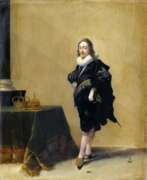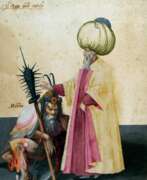Miniaturists 17th century


Louis Caravaque was a French portrait painter renowned for his contributions to Russian art during the early 18th century. Born in 1684 in Marseilles, France, Caravaque embarked on his artistic journey influenced by his family's background in decorative painting. His talent soon caught the attention of influential figures, leading to a pivotal contract in 1715 that took him to Russia. There, he famously painted Peter the Great and became a favored artist at the Russian court.
Caravaque's work is distinguished by his detailed and expressive portraiture, which earned him the position of the first court painter during Anna Ioannovna's reign. He played a significant role in the cultural exchanges between France and Russia, melding Western European techniques with Russian traditions. His notable works, which include portraits of Russian royalty and nobility, are held in prestigious collections such as the Hermitage and the Russian Museum in St. Petersburg.
Among his most celebrated paintings are the portraits of Peter the Great, Empress Elizabeth as an Olympic goddess, and Catherine II, showcasing his skill in capturing the grandeur and intricacy of his subjects. These artworks not only highlight his mastery of oil painting but also reflect the rich historical and cultural milieu of his time.
For collectors and art experts, the legacy of Louis Caravaque offers a fascinating glimpse into the intersection of French artistic influence and Russian imperial identity. His works remain a testament to his skill and the cultural bridge he helped forge between two distinct worlds.
For more information and to stay updated on exhibitions featuring Louis Caravaque’s work, consider signing up for updates related to this remarkable artist.


Joris Hoefnagel or Georg Hoefnagel was a Flemish painter, printmaker, miniaturist, draftsman and merchant. He is noted for his illustrations of natural history subjects, topographical views, illuminations and mythological works. He was one of the last manuscript illuminators and made a major contribution to the development of topographical drawing. His manuscript illuminations and ornamental designs played an important role in the emergence of floral still-life painting as an independent genre in northern Europe at the end of the 16th century. The almost scientific naturalism of his botanical and animal drawings served as a model for a later generation of Netherlandish artists. Through these nature studies he also contributed to the development of natural history and he was thus a founder of proto-scientific inquiry. Hoefnagel was a very versatile artist. He is known for his landscapes, emblems, miniatures, grotesques, topographical drawings, genre scenes, and mythological and allegorical drawings and paintings. Part of Hoefnagel's artistic works was kept by Constantijn Huygens his nephew. These works were seen by Dutch artists and exercised an important influence on the development of Dutch still life and naturalist art.


Hendrik Gerritsz. Pot, nicknamed Pot from the East Indies, was a Dutch painter-painter, miniaturist, and decorator. He was a member of the Guild of St. Luke of Haarlem. Poth's famous works include genre paintings, portraits, and still lifes in the vanitas style. Sweat has genre scenes depicting groups of young people leading merry lives, drinking, eating and flirting, but he also painted a series of portraits of the English royal family.


Johann Gottfried Tannauer was a German painter, portraitist, and miniaturist, renowned for his significant contributions to the art scene in Russia during the early 18th century. Born in 1680 in Saxony, Germany, Tannauer initially trained as a watchmaker and studied music before dedicating himself to painting. His artistic journey led him to Venice to study under Sebastiano Bombelli, and he also spent time in Holland, copying works by Rubens.
Invited to Russia by Peter the Great in 1710, Tannauer quickly rose to prominence within the Russian aristocracy, securing a role as a court painter. He was particularly appreciated for his ability to capture the essence and stature of his subjects, which included high-profile figures such as Tsar Peter I and his family. His artworks are notable for their dynamic Baroque style, characterized by intense color combinations and a sense of grandeur.
Several of Tannauer's works are preserved in prominent locations such as The Hermitage and the Russian Museum in St. Petersburg. His portraits are celebrated for their vivid portrayal and historical significance, offering a glimpse into the royal and noble personas of his time.
For those interested in exploring the works of Johann Gottfried Tannauer further, staying updated on exhibitions and sales can enrich your understanding of his impact on art history. You can sign up for updates related to Tannauer's artworks, ensuring you're informed about new insights and opportunities to view his masterpieces at auctions or exhibitions.













